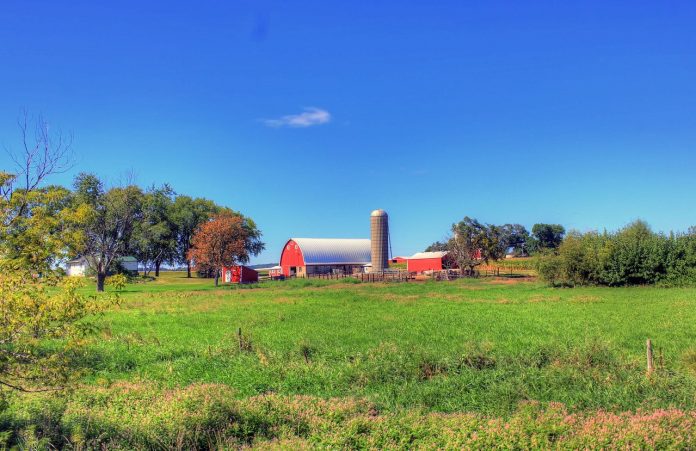“Beginning farmers in Indiana, Illinois and Missouri in the postwar decade who made a start other than the home farm started on farms of 160 to 200 acres. Smaller acreages, if operated as general farms with little livestock, will not provide full or efficient employment for one man.
A sample of Illinois farmers who operated grain farms used 14 months of labor in 1955 on 170 acres of tillable land. Their average livestock inventory was 2 dairy cows, 100 hens, 9 animal units of beef cattle and sheep, and 7 litters of pigs. Their inventory of machinery and equipment (at used-machinery prices) was about $4,800.”
— Land, The 1958 Yearbook, USDA
Part Three
Farm enlargements is a term that came up time and time again in the 600-page book distributed to farmers by the United States Department of Agriculture in 1958.
It came about because of economics applied, simply and succinctly.
The discussion of land and young farmers coming of age in the 1950s leaned heavily on finding a leg up by securing rental ground of “neighbors all around you” and along with that, some, it was said, will even offer their machinery to get the job done.
It could become a toss-up debate at the next community get-together: which has changed more, the neighboring farm ground or the machinery to borrow from those neighbors.
Enlargement
One of my favorite books to pluck off the shelf above my writing desk remains The Contrary Farmer, by Gene Logsdon.
As I was studying the changing environment from the time this 1958 USDA book came out, I considered Logsdon’s opposing philosophy that bigger farming brings steeper debt that can strangle a farm.
As I read the USDA book advising farmers to focus on farm enlargement and the purchase of more powerful machinery in order to make better use of their time, I recalled a great quotation Logsdon had used early in his book. It opens chapter 2, entitled Pastoral Economics.
“A farm is like a man — however great the income, if there is extravagance, but little is left.”
Cato wrote this on agriculture, circa 200 BC. Isn’t it amazing how this thought remains as true today as in 200 BC?
One wonders what the extravagance at hand was for farmers in that long ago land. Today, this possibility is endless.
Bigger and better
It is this insatiable drive for more and bigger and brightest paint that brought the contrariness out in Logsdon.
This dance of opposing views of the land a life is gleaned upon goes back to the beginning of time.
I was a young reporter, working my way up through the daily newspaper grind, and the first in the newsroom to volunteer for everything agriculture.
It was the early 1980s, and perhaps never before in history had farming suffered the whiplash it was careening upon.
After the sweetness of the 1970s, suddenly a bombardment of two nightmarish consequences rained down on U.S. farmers: interest rates spiked to frighteningly high percentage numbers as never before seen, and the rapidly increasing cost of fuel drove every farm input beyond manageable reach for many.
I covered a farmers’ protest march, followed by various speaking events with the focus on surviving this crushing weight of circumstances.
I traveled to Washington, D.C., for a symposium which offered speakers on every possible angle to help farmers through this. I took notes, I asked questions, I felt myself hanging on for dear life for the sake of everyone I cared about.
Thoughts
My Dad had stayed quiet through it all. One night, just the two of us sat on his porch late one evening after a busy day of making hay.
I asked how he felt about the protest marches being covered in the national news. As usual, he bought a little time by filling his pipe with Sir Walter Raleigh just so, looking out upon the horizon.
He was a man of few words. When asked, he wanted to speak the way he fully meant to answer.
“Well, it might feel like the right thing to do for some. I’m just going to stay home and keep doing what I’ve always done. I’m going to work. Make the place show a profit every day the best way I know.
“As for this awful interest rate, farm credit banks don’t have any control over it. They need farmers to make payments as they have agreed to do, and the farmers need those banks to survive. The strongest will hopefully survive this, but it could be that none of us will.
“My bet is the ones who make it are the ones who have farmed lean, don’t carry too much debt, don’t spend money on extra anything, get up early and farm smart all year long, no matter what is going on in the world.”
Survival
My parents survived it, and went on to buy additional ground as the farm crisis leveled away. But I will never forget our talk that night.
Whether farming large or small, so much is out of the farmer’s control, buying retail and selling wholesale. It seems mighty unfair so much of the time.
But, as my father neared his last days at age 63, another talk stays with me.
“I am the luckiest guy, because I got to do exactly what I wanted to do, every single day. Not very many people get to say that.”













